Commander Legends: Battle for Baldur's Gate Mechanics
The beloved adventure of Dungeons & Dragons returns to Magic once more in Commander Legends: Battle for Baldur's Gate. This set visits one of D&D's most iconic settings, introduces some exciting new mechanics, brings back popular mechanics like roll a d20, and even brings a new twist to some other returning mechanics. Before I get into too many details, however, let me give you some background.
BACKGROUNDS
Specifically, these Backgrounds:
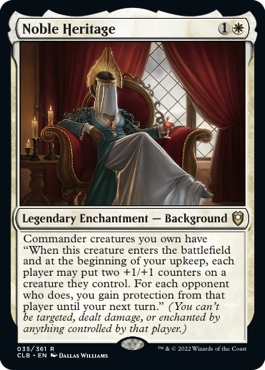
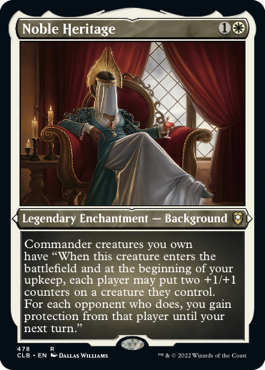
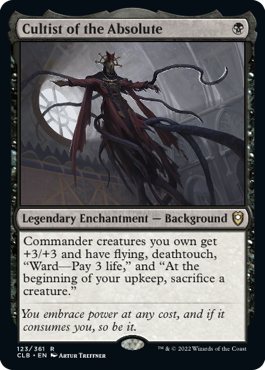
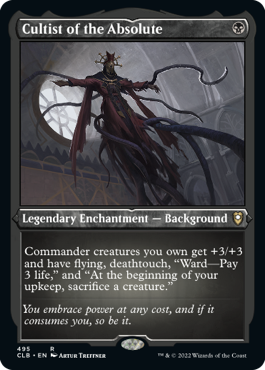
Backgrounds are a new type of enchantment. Legendary Background cards represent the story that brought your commander to the point where we find them now. Each one gives your commander a bonus that will help them (and therefore help you) in the game. Most often, this bonus comes in the form of an ability your commander gains or a boost to their power and/or toughness.
CHOOSE A BACKGROUND
A Background enchantment that's in your commander's color identity can, of course, be played in a Commander deck just like any other card. Some legendary creatures in this set, however, have an ability that allows them to start the game with a Background in the command zone.
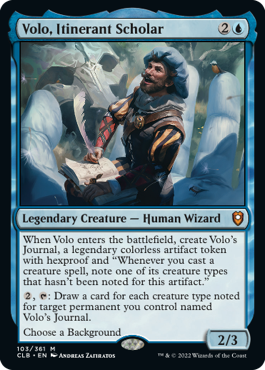

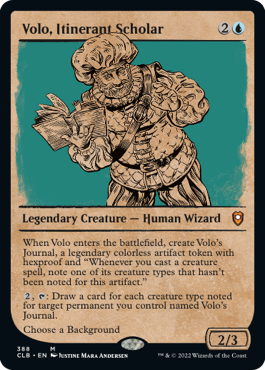
One thing to note about Volo, Itinerant Scholar (aside from all those creature types) is that it has an ability called "choose a Background." Choose a Background is a very specific version of the partner ability, which can allow a player to have more than one commander. If the legendary creature you've chosen as your commander has chosen a Background, you may start the game with both that creature and a legendary Background enchantment in the command zone. If you do, that Background functions as a second commander for your deck. This means that the Background can have a different color identity from the legendary creature and you use the combined color identity of both the legendary creature card and the legendary Background card to determine what the other 98 cards in your Commander deck (or 58 cards in Commander draft) can be.
For purposes other than color identity, that Background is treated as an individual commander on its own. If it is put into your graveyard, exiled, or would otherwise leave the battlefield, you may put it back into the command zone. "Commander tax," the additional cost of two mana for every time you've cast a commander from the command zone, applies separately to your Background.
Some cards, usually Backgrounds themselves, refer to "commander creatures." Those don't refer to a Background enchantment that is a commander unless it is also a creature. For other purposes, however, if a card refers to your commander, it means either the legendary creature or the legendary Background enchantment. So cards like Command Beacon (not in this set, but still a popular option) can fetch either the legendary creature or the legendary Background. Anything that cares about whether you control your commander will be satisfied if you control one or both of them. Cards like Command Tower (which is in this set!) can add mana of either of your commander's color identities.
THE INITIATIVE
Any veteran of the game can tell you that initiative is pretty important in Dungeons & Dragons, and it's important in Commander Legends: Battle for Baldur's Gate as well. In Magic terms, the initiative is a designation that a player can have during the game (similar to the monarch from some other sets). When the game starts, no player has the initiative, and there are three ways for a player to take the initiative. The most direct way is cards like White Plume Adventurer.
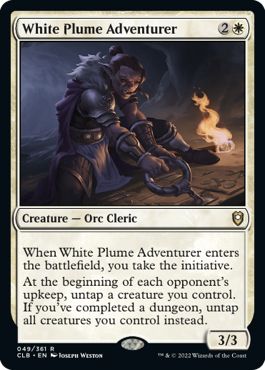
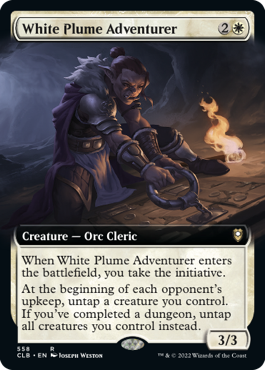
The second way to take the initiative is to attack the player who currently has the initiative. If a creature you control deals combat damage to that player, you take the initiative. Once you do, though, be prepared to defend it! Other players will surely try to take it from you just as quickly.
The third way to take the initiative is if the player who currently has the initiative leaves the game. When that happens, the player whose turn it is takes the initiative. If the player who has the initiative leaves the game on their own turn, or the active player left the game at the same time, the next player in turn order takes the initiative.
Once a player has the initiative, there will only be one initiative designation for the rest of the game. As one player takes the initiative, the existing player who has the initiative (if there is one) loses it.
Why do you want the initiative? Well, there are three significant bonuses to having the initiative: First, whenever a player takes the initiative, they venture into Undercity (Undercity is a new dungeon card; see "Dungeons" below). This will happen even if that player already had the initiative at the time. Second, the player with the initiative ventures into Undercity again at the beginning of their upkeep. Third, several cards in the set get better if you have the initiative.
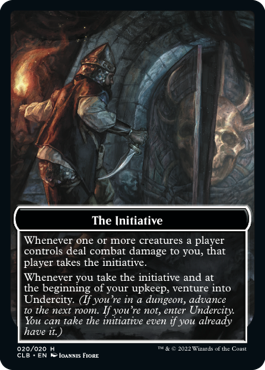
DUNGEONS
Dungeons, as you might guess from the name, are an important part of the Dungeons & Dragons experience. Dungeon cards were first introduced in Dungeons & Dragons: Adventures in the Forgotten Realms, along with the keyword ability venture into the dungeon. The card type is making a return in this set with Undercity, a new dungeon card.
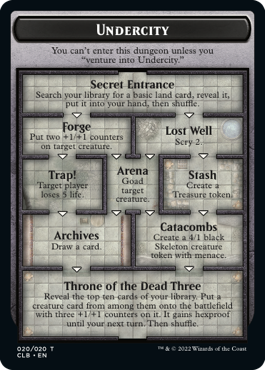
Just like previous dungeon cards, Undercity starts outside the game and can end up in the command zone for a while. Players can enter Undercity using only the new keyword action "venture into Undercity," a special version of venture into the dungeon. Players venture into Undercity when they take the initiative and, if they still have the initiative, at the beginning of their upkeep. (See "The Initiative" above).
For the most part, venture into Undercity and venture into the dungeon work the same way. If a player is already in a dungeon when they venture into Undercity, they will move to the next room of that dungeon (even if it isn't Undercity). However, if a player isn't already in a dungeon when they venture into Undercity, that player doesn't get to choose which dungeon card to put into the command zone. Instead, they must put the Undercity dungeon card into the command zone. The rest of the process works the same way. They put their venture marker on the first room of Undercity, at the top, and that room's ability triggers.
If you venture into the dungeon using a card from Adventures in the Forgotten Realms, you can't choose to start the Undercity dungeon. However, if you're already in the Undercity dungeon, you will move your marker to the next room in Undercity. Since you can't be in two places at once (that's just physics), each player is still limited to having only one dungeon card in the command zone at a time. For example, you could be in either Undercity or Lost Mine of Phandelver, but not both. You'd have to finish one in order to start the other.
For more detailed information about the venture into the dungeon keyword action and previously printed dungeon cards, please check out the Adventures in the Forgotten Realms Mechanics article.
& DRAGONS
Oh, uh
Dragons, as you might also guess from the name, are an equally important part of the Dungeons & Dragons experience, and many of them appear in this set. We weren't going to do this joke again, but apparently it's required in a contract somewhere. This may or may not be [autocard mvid="479448"]Stet[/autocard]'s fault.
& . . . GATES?
Okay, this is getting silly. Just because the set is named
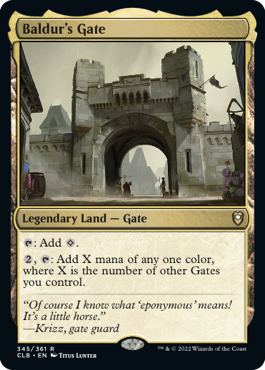

Gate is a returning land type. It doesn't have any inherent rules meaning, but some Gates, including some found in this set, have abilities that care either about which other Gates you control or the number of other Gates you control.
MYRIAD
Myriad is a returning mechanic that lets a creature attack in all possible directions. Whenever a creature you control with myriad attacks, for each opponent other than the defending player, you may create a token that is a copy of that creature to attack that opponent or a planeswalker that opponent controls. With myriad, you can attack everyone at once or, if you're feeling particularly political, just some of them. Because you "may" create each token, you can decline to create tokens for some of your opponents. Attacking a planeswalker will also cause myriad to trigger, as the planeswalker's controller is the defending player.
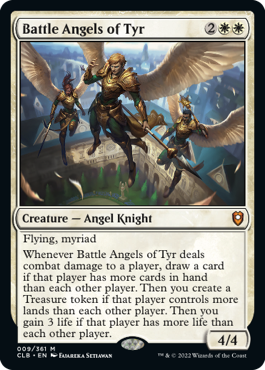
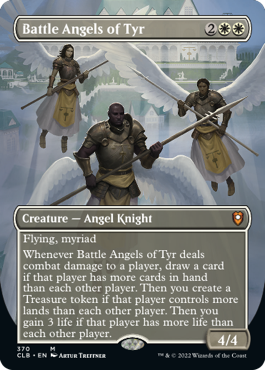
The tokens basically copy what's printed on the creature with myriad and not much else. If Battle Angels of Tyr has any Auras or Equipment attached to it, those don't get copied. The same is true for +1/+1 counters or any non-copy effect that has changed its power, toughness, or abilities. At end of combat, the tokens are exiled. They don't go to the graveyard, so no abilities that trigger whenever a creature dies will trigger.
Another important point is that the tokens enter the battlefield tapped and attacking. This means they were never declared as attackers. If you have any abilities that trigger whenever a creature attacks, those abilities won't trigger. Put another way, myriad won't cause itself to trigger.
ADVENTURES
Last, but certainly not least, we have a returning mechanic that feels right at home with D&D—adventurer cards.
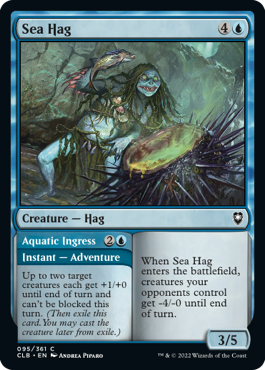
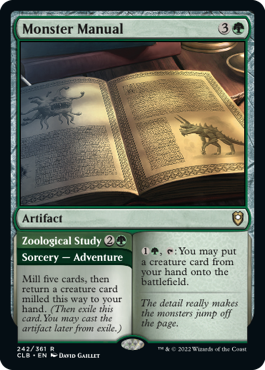
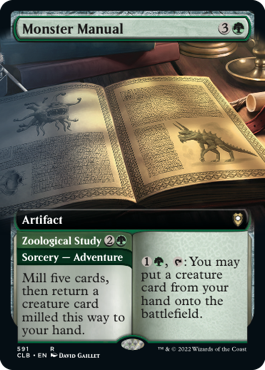
Volo would note that Monster Manual is not a creature card. In fact, the release of Commander Legends: Battle for Baldur's Gate marks the first time that a noncreature permanent has an Adventure printed on it. Otherwise, however, adventurer cards and Adventures are pretty much unchanged from when they first appeared in Throne of Eldraine.
As you play a card with an Adventure, you choose whether you are casting the permanent spell or the Adventure spell. The permanent spell has its usual text box on the right, and the Adventure spell has its own text box on the left, complete with its own name, types, and mana cost. If you cast it as a permanent, it enters the battlefield normally as it resolves.
Casting it as an Adventure is very similar. It goes on the stack as an Adventure spell and can be responded to or even countered as normal. If it resolves, you follow its instructions, but instead of putting it into your graveyard as it resolves, you exile it. Now your card is on an adventure! "How does a book take an adventure," you ask? Maybe it travels in the knapsack of a legendary storyteller, or perhaps sits next to a window in a dreaded pirate captain's cabin. Or, just maybe, it discovers that the real adventure was inside it all along.
Anyway, when you want your card to be done with its adventure, it can return safely. If a card was exiled because you cast it as an Adventure, you may cast the permanent spell from exile! This only works if the Adventure spell resolved and the card remained in exile. If the spell was countered, you're out of luck.
While an adventurer card is on the battlefield, just ignore the Adventure and all its text. While the card is in your hand, your graveyard, your library, even exile, it has only the characteristics of the permanent, not the Adventure.
TO ADVENTURE!
Whether at release events or playing with friends and family at home, you'll find that Commander Legends: Battle for Baldur's Gate is full of powerful cards, fun new mechanics, clever references, and more than a little nostalgia for D&D fans. So, what are you waiting for? Gather up your party and get ready for adventure!
